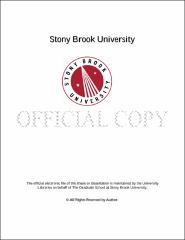| dc.identifier.uri | http://hdl.handle.net/11401/77170 | |
| dc.description.sponsorship | This work is sponsored by the Stony Brook University Graduate School in compliance with the requirements for completion of degree. | en_US |
| dc.format | Monograph | |
| dc.format.medium | Electronic Resource | en_US |
| dc.language.iso | en_US | |
| dc.publisher | The Graduate School, Stony Brook University: Stony Brook, NY. | |
| dc.type | Dissertation | |
| dcterms.abstract | The world faces urgent problems related to global water pollution. New fast, efficient, green, and cost-effective purification technologies can play a crucial role in solving contamination issues and offering fresh water supplies. In this research, two of the most abundant natural polysaccharides, cellulose and chitin, are extracted from wood pulp and shrimp shells, respectively, by using a series of chemical/physical treatments to produce nanofibers of 5 nm to 20 nm in width and a few microns in length, and investigated as functional components in water purification membranes. These naturally occurring nanofibers were thiol-modified to improve their ability to adsorb heavy metal ions, such as chromium, lead and arsenic from polluted water. In addition, these thiol-modified nanofibers were incorporated into high-flux fibrous microfiltration membranes fabricated by electrospinning to make nanofibrous composite membranes with high adsorption capacity of heavy metal ions (such as chromium, lead and arsenic), due to the large surface area-to-volume ratio and effective chemical functionality. The modified nanofibrous composite membranes also demonstrated good stability and could be used and regenerated multiple times with high recovery efficiency after metal ion removal. Furthermore, novel ultrafiltration membranes were created by radical polymerization within the cellulose nanofibrous top barrier layer of the composite membrane. One example membrane could reject contaminated particles with sizes larger than 15 nm from water and also demonstrated excellent chemical resistance. | |
| dcterms.available | 2017-09-20T16:52:08Z | |
| dcterms.contributor | Chu, Benjamin | en_US |
| dcterms.contributor | Grubbs, Robert | en_US |
| dcterms.contributor | Hsiao, Benjamin | en_US |
| dcterms.contributor | Rudick, Jonathan | en_US |
| dcterms.contributor | Mahajan, Devinder. | en_US |
| dcterms.creator | Yang, Rui | |
| dcterms.dateAccepted | 2017-09-20T16:52:08Z | |
| dcterms.dateSubmitted | 2017-09-20T16:52:08Z | |
| dcterms.description | Department of Chemistry. | en_US |
| dcterms.extent | 161 pg. | en_US |
| dcterms.format | Application/PDF | en_US |
| dcterms.format | Monograph | |
| dcterms.identifier | http://hdl.handle.net/11401/77170 | |
| dcterms.issued | 2015-08-01 | |
| dcterms.language | en_US | |
| dcterms.provenance | Made available in DSpace on 2017-09-20T16:52:08Z (GMT). No. of bitstreams: 1
Yang_grad.sunysb_0771E_11773.pdf: 3783291 bytes, checksum: 9b274fe3859b67f921c85f6e6f6927ba (MD5)
Previous issue date: 2014 | en |
| dcterms.publisher | The Graduate School, Stony Brook University: Stony Brook, NY. | |
| dcterms.subject | Chemistry | |
| dcterms.subject | Adsorptoin, Cellulose, Chitin, Heavy metal ions, Thiol, Water Purification | |
| dcterms.title | Functionalized Nanofibrous Materials for Water Purification | |
| dcterms.type | Dissertation | |

